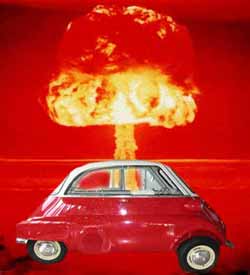Hydrogen Bomb – H2 Car Misnomer
The term ‘hydrogen bomb’ most likely will be given with dubious distinction to one of the early hydrogen cars that don’t make the grade in the consumer market. Some people fear the new hydrogen cars, calling them names like Hindenburg or Hydrogen Bombs, but nothing could be further from the truth.
 |
The hydrogen bombs developed in the 1950’s were thermonuclear weapons capable of incinerating an area 150 miles square and blasting radioactive and thermal fallout to an area of 800 miles square. |
The nuclear reaction was created by the fusion of two hydrogen atoms (the lightest element in the universe) into one helium atom (the second lightest atom), releasing massive amounts of energy along the way.
A hydrogen bomb is a composite bomb. Because the most extreme temperatures are needed for hydrogen fusion to occur, an atomic fission reaction occurs first in order to generate enough heat for the fusion to occur.
In a hydrogen car running on a fuel cell, the reaction is much different. Atoms of hydrogen and oxygen (the eighth lightest atom) are fused together, creating much lower amounts of energy and a byproduct of water (H2O). In addition, without an atomic bomb onboard, the hydrogen car has no way of generating enough heat for a nuclear fusion reaction to occur.
Because of the historical publicity of the destructive uses of hydrogen, as in bombs and zeppelins, much of the public has a negative or overly cautious perception of the use of hydrogen to power cars and other vehicles. The hydrogen cars being developed today have many safety features, such as better seals and carbon-composite fuel tanks, that make as safe or safer than the standard fossil fuel vehicles.
The term ‘hydrogen bomb’ will be such as easy name for the media to place upon a new H2 car, that the manufacturers are being extremely careful not to inherit such a name.
Written by Hydro Kevin Kantola